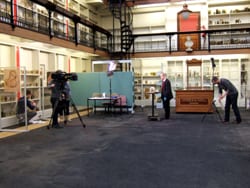Ian Hislop and the Galton Head Spanner
By Subhadra Das, on 10 October 2012
 At the risk of sounding celebrity obsessed; one of our objects was on the telly last night!
At the risk of sounding celebrity obsessed; one of our objects was on the telly last night!
A head spanner originally used by the Galton Laboratory and now part of the UCL Galton collection appeared in ‘Ian Hislop’s Stiff Upper Lip’ on BBC2. The second in a 3-part self-described ‘emotional history of Britain’ focussed on how the Victorians embraced the stiff upper lip as an empire building tool. Used to take accurate measurements of human skulls, this head spanner, and others like it, contributed to the colonial project of keeping colonials… well, colonial.
As someone who has relinquished an Indian passport to take on the mantle of Britishness[1]*there are lots of issues I could talk about here, but I’m also a museum curator and so enjoy getting het up about very little things rather than massive philosophical and social issues.
So, I thought I would 1) write and let you know that you can catch-up with the series on the BBC iPlayer And 2) give you an insight into the practical, professional and ethical aspects of lending an object for filming a documentary.
It went a little something like this:
- Receive email from film production company describing TV documentary starring Ian Hislop, much beloved editor of Private Eye and TV satirist.
- Worry that the simplification inherent in any TV documentary, even if it is on the BBC, will mean that everyone will think that Galton was just a fascist.
- Worry that you are becoming an apologist for Galton.
- Do it anyway.
- The day before filming, receive an email from film production company asking 1. Would it be possible for famous TV satirist to handle the head spanner and use it himself and 2. How do you use a head spanner, exactly?
- Have concerns that Ian Hislop will look like a fascist. Also have concerns about conservation issues. Write back and ask for clarification re: use, explaining the potential ethical firestorm and say instructions to follow.
- Panic when you can’t find the instructions for how to use a head spanner.
- Receive a reply saying that TV satirist would be using the head spanner on himself.
- Think ‘That would be a trick, I’d like to see that,’ and reply fine, provided he wears gloves.
- On the day of filming, pack the head spanner along with a selection of other objects requested. By the greatest good fortune, discover a colleague has a copy of the instructions of how to use a head spanner. Print these off to read in the taxi.
- Meet a PhD student specialising in the History of Science who is your back-up in case everything goes Channel 5 on you, hail a taxi and head to the filming venue. In this case, the fantastic Pathology Museum at St. Bart’s. Arrive at the venue, unpack the objects in a mini-museum exhibition, ready to amaze.
- Meet the crew who say all the objects are amazing, but it really is just the head spanner that they are interested in using, thanks. How does it work?
- Show them the instructions and read them through together.
- Meet Ian Hislop and marvel at how much he looks just like he does on television.
- Negotiate terms for the handling of the head spanner on camera. Assure everyone that blue nitrile gloves will make beloved TV satirist look infinitely more professional than white cotton ones.
- Receive assurance from TV satirist that this isn’t just having a go at Galton. Darwin will get in in the neck as well. So that’s all right.
- Watch them film the scene, paying very careful attention to every word of the script in case of content snafus.
- Attempt to do this for the next 17 takes, but rapidly lose interest.
- Be relieved that the filming is over, the object is in one piece and you can pack everything up and go home.
- Some months later, receive email from production company saying, do you remember when we filmed and the renowned TV satirist took a measurement in millimetres? Is that right? Did the Victorians have millimetres?
- Conduct some in-depth research of Galton’s publications and establish that Galton did indeed use millimetres. This makes sense given his scrupulous exactitude with all things.
- Receive a reply with thanks and assurances that they will let us know before the show goes on air.
- Some more months later, hear a trailer for the show after listening to Women’s Hour on Radio 4.
- Diligently watch the first and second episodes waiting for the object to turn up. Look on with pride as ‘UCL Museums & Public Engagement’ appears in the ‘Thanks to’ section of the credits.
- Write a blog to tell the world and generally show off.
If any of you are wondering if I’ve regretted this decision, the answer is no. It’s a good, solid series which manages to cram 300-odd years of history into 3 hours and makes a good argument for an interesting thesis. And what it something had gone wrong? The answer to that is easy:
26. We are British. Keep calm and carry on.
Subhadra Das is Curator of the UCL Galton and Pathology Collections, and is one of a team working across UCL Teaching & Research Collections.
[1] I took the Citizenship test and swore and oath to the Queen. I can now make up words if I like.
 Close
Close


